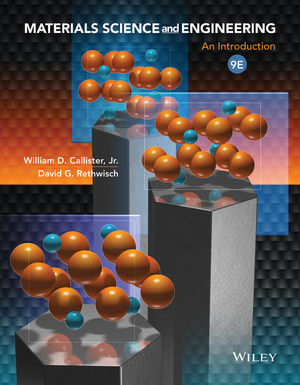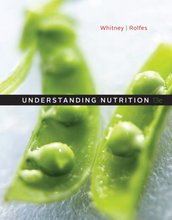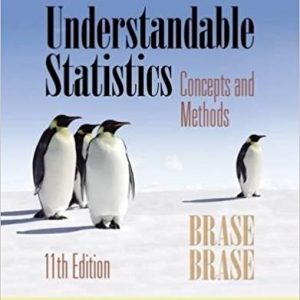Solution Manual for Materials Science and Engineering: An Introduction, 9th Edition, William D. Callister, David G. Rethwisch

Product details:
- ISBN-10 : 1118477707
- ISBN-13 : 978-1118477700
- Author: William D. Callister
Building on the extraordinary success of eight best-selling editions, Callisters new Ninth Edition of Materials Science and Engineering continues to promote student understanding of the three primary types of materials (metals, ceramics, and polymers) and composites, as well as the relationships that exist between the structural elements of materials and their properties. This edition is again supported by WileyPLUS, an integrated online learning environment, (when ordered as a package by an instructor). Also available is a redesigned version of Virtual Materials Science and Engineering (VMSE). This resource contains interactive simulations and animations that enhance the learning of key concepts in materials science and engineering (e.g., crystal structures, crystallographic planes/directions, dislocations) and, in addition, a comprehensive materials property database.
Table contents:
- 1.1 HISTORICAL PERSPECTIVE
- 1.2 MATERIALS SCIENCE AND ENGINEERING
- 1.3 WHY STUDY MATERIALS SCIENCE AND ENGINEERING?
- 1.4 CLASSIFICATION OF MATERIALS
- 1.5 ADVANCED MATERIALS
- 1.6 MODERN MATERIALS’ NEEDS
- Chapter 2 Atomic Structure And Interatomic Bonding
- Practice and Homework Problems
- Questions and Problems
- Spreadsheet Problem
- Fundamentals of Engineering Questions and Problems
- Summary and Study Guide
- Equation Summary
- List of Symbols
- Important Terms and Concepts
- Study Resources
- Section 2.6
- Section 2.7
- Additional Study Resources
- Readings
- 2.1 INTRODUCTION
- 2.2 FUNDAMENTAL CONCEPTS
- 2.3 ELECTRONS IN ATOMS
- 2.4 THE PERIODIC TABLE
- 2.5 BONDING FORCES AND ENERGIES
- 2.6 PRIMARY INTERATOMIC BONDS
- 2.7 SECONDARY BONDING OR VAN DER WAALS BONDING
- 2.8 MIXED BONDING
- 2.9 MOLECULES
- 2.10 BONDING TYPE-MATERIAL CLASSIFICATION CORRELATIONS
- Chapter 3 The Structure of Crystalline Solids
- Practice and Homework Problems
- Questions and Problems
- Spreadsheet Problem
- Fundamentals of Engineering Questions and Problems
- Summary and Study Guide
- Equation Summary
- List of Symbols
- Important Terms and Concepts
- Study Resources
- Section 3.4
- Section 3.7
- Section 3.9
- Section 3.10
- Section 3.12
- Additional Study Resources
- Readings
- 3.1 INTRODUCTION
- 3.2 FUNDAMENTAL CONCEPTS
- 3.3 UNIT CELLS
- 3.4 METALLIC CRYSTAL STRUCTURES
- 3.5 DENSITY COMPUTATIONS
- 3.6 POLYMORPHISM AND ALLOTROPY
- 3.7 CRYSTAL SYSTEMS
- 3.8 POINT COORDINATES
- 3.9 CRYSTALLOGRAPHIC DIRECTIONS
- 3.10 CRYSTALLOGRAPHIC PLANES
- 3.11 LINEAR AND PLANAR DENSITIES
- 3.12 CLOSE-PACKED CRYSTAL STRUCTURES
- 3.13 SINGLE CRYSTALS
- 3.14 POLYCRYSTALLINE MATERIALS
- 3.15 ANISOTROPY
- 3.16 X-RAY DIFFRACTION: DETERMINATION OF CRYSTAL STRUCTURES
- 3.17 NONCRYSTALLINE SOLIDS
- Chapter 4 Imperfections in Solids
- Practice and Homework Problems
- Questions and Problems
- Spreadsheet Problem
- Fundamentals of Engineering Questions and Problems
- Summary and Study Guide
- Equation Summary
- List of Symbols
- Important Terms and Concepts
- Study Resources
- Section 4.2
- Section 4.3
- Section 4.4
- Section 4.5
- Section 4.6
- Additional Study Resources
- Readings
- 4.1 INTRODUCTION
- 4.2 VACANCIES AND SELF-INTERSTITIALS
- 4.3 IMPURITIES IN SOLIDS
- 4.4 SPECIFICATION OF COMPOSITION
- 4.5 DISLOCATIONS—LINEAR DEFECTS
- 4.6 INTERFACIAL DEFECTS
- 4.7 BULK OR VOLUME DEFECTS
- 4.8 ATOMIC VIBRATIONS
- 4.9 BASIC CONCEPTS OF MICROSCOPY
- 4.10 MICROSCOPIC TECHNIQUES
- 4.11 GRAIN-SIZE DETERMINATION
- Chapter 5 Diffusion
- Practice and Homework Problems
- Questions and Problems
- Design Problems
- Spreadsheet Problem
- Fundamentals of Engineering Questions and Problems
- Summary and Study Guide
- Equation Summary
- List of Symbols
- Important Terms and Concepts
- Study Resources
- Section 5.1
- Section 5.2
- Section 5.3
- Section 5.4
- Section 5.5
- Additional Study Resources
- Readings
- 5.1 INTRODUCTION
- 5.2 DIFFUSION MECHANISMS
- 5.3 FICK’S FIRST LAW
- 5.4 FICK’S SECOND LAW—NONSTEADY-STATE DIFFUSION
- 5.5 FACTORS THAT INFLUENCE DIFFUSION
- 5.6 DIFFUSION IN SEMICONDUCTING MATERIALS
- 5.7 OTHER DIFFUSION PATHS
- Chapter 6 Mechanical Properties of Materials
- Practice and Homework Problems
- Questions and Problems
- Design Problems
- Spreadsheet Problem
- Fundamentals of Engineering Questions and Problems
- Summary and Study Guide
- Equation Summary
- List of Symbols
- Important Terms and Concepts
- Study Resources
- Section 6.02
- Section 6.03
- Section 6.06
- Section 6.10
- Additional Study Resources
- Readings
- 6.1 INTRODUCTION
- 6.2 CONCEPTS OF STRESS AND STRAIN
- 6.3 STRESS-STRAIN BEHAVIOR
- 6.4 ANELASTICITY
- 6.5 ELASTIC PROPERTIES OF MATERIALS
- 6.6 TENSILE PROPERTIES
- 6.7 TRUE STRESS AND STRAIN
- 6.8 ELASTIC RECOVERY AFTER PLASTIC DEFORMATION
- 6.9 COMPRESSIVE, SHEAR, AND TORSIONAL DEFORMATIONS
- 6.10 HARDNESS
- 6.11 VARIABILITY OF MATERIAL PROPERTIES
- 6.12 DESIGN/SAFETY FACTORS
- Chapter 7 Dislocations and Strengthening Mechanisms
- Practice and Homework Problems
- Questions and Problems
- Design Problems
- Fundamentals of Engineering Questions and Problems
- Summary and Study Guide
- Equation Summary
- List of Symbols
- Important Terms and Concepts
- Study Resources
- Section 7.2
- Section 7.3
- Section 7.7
- Section 7.8
- Section 7.9
- Section 7.10
- Section 7.12
- Section 7.13
- Additional Study Resources
- Readings
- 7.1 INTRODUCTION
- 7.2 BASIC CONCEPTS
- 7.3 CHARACTERISTICS OF DISLOCATIONS
- 7.4 SLIP SYSTEMS
- 7.5 SLIP IN SINGLE CRYSTALS
- 7.6 PLASTIC DEFORMATION OF POLYCRYSTALLINE MATERIALS
- 7.7 DEFORMATION BY TWINNING
- 7.8 STRENGTHENING BY GRAIN SIZE REDUCTION
- 7.9 SOLID-SOLUTION STRENGTHENING
- 7.10 STRAIN HARDENING
- 7.11 RECOVERY
- 7.12 RECRYSTALLIZATION
- 7.13 GRAIN GROWTH
- Chapter 8 Failure
- Practice and Homework Problems
- Questions and Problems
- Design Problems
- Spreadsheet Problem
- Fundamentals of Engineering Questions and Problems
- Summary and Study Guide
- Equation Summary
- List of Symbols
- Important Terms and Concepts
- Study Resources
- Section 8.1
- Section 8.6
- Section 8.8
- Section 8.9
- Additional Study Resources
- Readings
- 8.1 INTRODUCTION
- 8.2 FUNDAMENTALS OF FRACTURE
- 8.3 DUCTILE FRACTURE
- 8.4 BRITTLE FRACTURE
- 8.5 PRINCIPLES OF FRACTURE MECHANICS
- 8.6 FRACTURE TOUGHNESS TESTING
- 8.7 CYCLIC STRESSES
- 8.8 THE S–N CURVE
- 8.9 CRACK INITIATION AND PROPAGATION
- 8.10 FACTORS THAT AFFECT FATIGUE LIFE
- 8.11 ENVIRONMENTAL EFFECTS
- 8.12 GENERALIZED CREEP BEHAVIOR
- 8.13 STRESS AND TEMPERATURE EFFECTS
- 8.14 DATA EXTRAPOLATION METHODS
- 8.15 ALLOYS FOR HIGH-TEMPERATURE USE
- Chapter 9 Phase Diagrams
- Practice and Homework Problems
- Questions and Problems
- Fundamentals of Engineering Questions and Problems
- Summary and Study Guide
- Equation Summary
- List of Symbols
- Important Terms and Concepts
- Study Resources
People also search:
materials science and engineering 9th edition
callister materials science and engineering 9th
materials science and engineering 9th edition si version
materials science and engineering an introduction 9th edition
materials science and engineering an introduction 9th
what is material science and engineering all about





